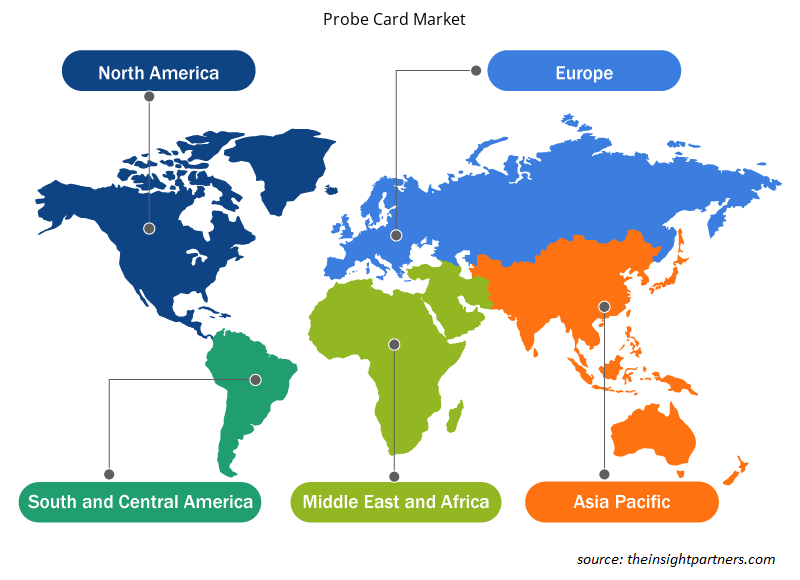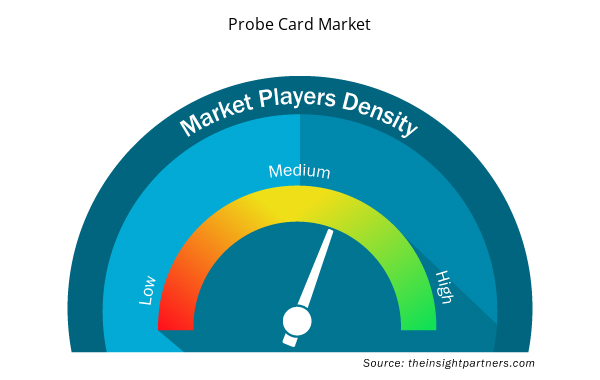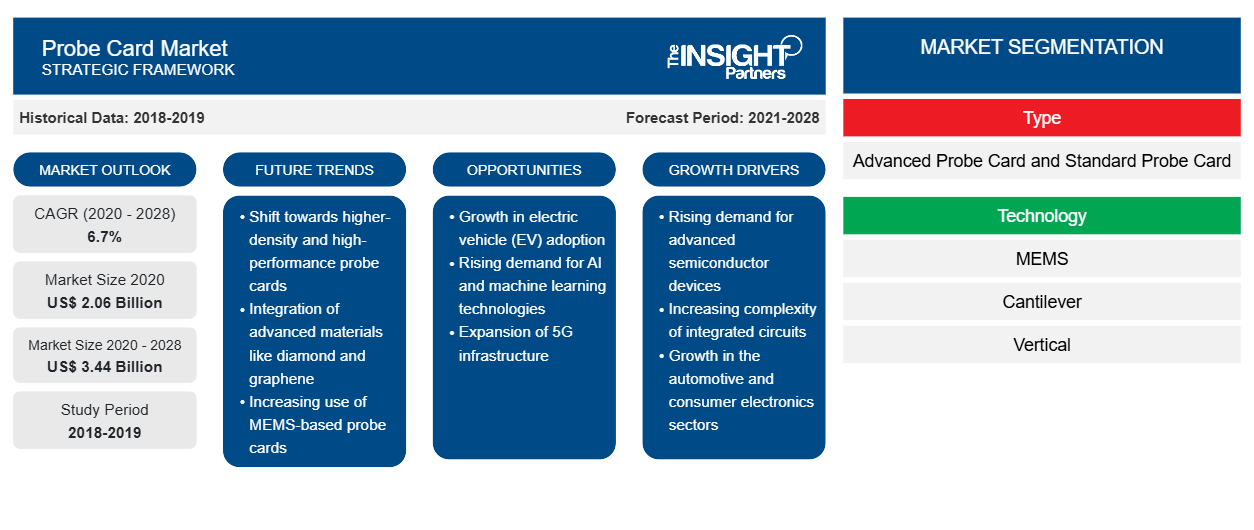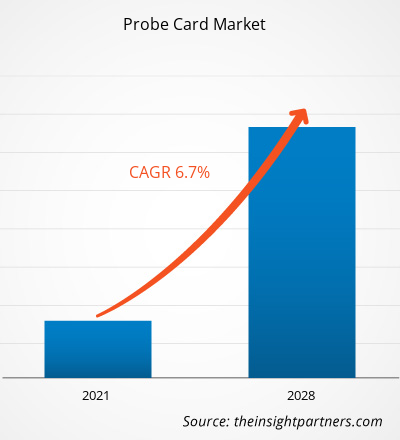Der Markt für Prüfkarten soll von 2.059,80 Millionen US-Dollar im Jahr 2020 auf 3.436,80 Millionen US-Dollar im Jahr 2028 anwachsen; für den Zeitraum 2021–2028 wird ein gesundes Marktwachstum von durchschnittlich 6,7 % jährlich erwartet.
Eine Prüfkarte ist eine Schnittstelle, die das Testen eines Halbleiterwafers ermöglicht. Im ersten Schritt der Halbleiterherstellung wird dieses Verfahren verwendet, um die Qualität integrierter Schaltkreise oder die latente semantische Indizierung zu beurteilen. In den meisten Fällen wird die Prüfkarte mechanisch an einen Prüfer angedockt und elektrisch mit einem Tester verbunden. Der Hauptzweck einer Prüfkarte besteht darin, eine elektrische Verbindung zwischen dem Testgerät und den Schaltkreisen auf dem Wafer herzustellen, damit die Schaltkreise getestet werden können. Leiterplatten (PCB) und verschiedene Arten von Kontaktelementen sind die grundlegenden Komponenten von Prüfkarten. Eine Prüfkarte berücksichtigt eine Vielzahl von Elementen, von denen einige recht häufig vorkommen und andere einen sehr spezifischen Einsatz haben.
Das Geschäft mit Unterhaltungselektronik hat sich aufgrund der zunehmenden Nutzung von Mobiltelefonen, Desktops, Digitalkameras, Tablets, Laptops, Festplatten und Fernsehgeräten sowie der ständigen Forschung und Einführung neuer Technologien weiterentwickelt. Die Einführung intelligenter Geräte und des Internets der Dinge sowie die zunehmende Akzeptanz von Tablets und die steigende Nachfrage nach Geräten mit riesigen Bildschirmen tragen alle zum Wachstum des Sondenmarktes bei. Die Nachfrage nach Halbleitern wurde durch Änderungen der Chipgrößentrends und eine zunehmende Vorliebe für kreative Architektur in verschiedenen elektronischen Produkten angeheizt. Die zunehmende Größe der IC-Chip-Herstellung führte zu einem Boom der Nachfrage nach Elektroniktests, was den Bedarf an Sondenkarten in die Höhe treibt. Die Einbindung moderner Technologien wie KI und IoT in die Halbleiterproduktionsausrüstung wird deren Akzeptanz in Fertigungsanlagen beschleunigen. Darüber hinaus sind der erhöhte Bedarf an siliziumbasierten Sensoren für IoT-Geräte, die wachsende Präsenz der Chipindustrie in Schwellenländern und eine zunehmende Anzahl von Rechenzentren und Servern Faktoren, die zur Leistungssteigerung der Halbleiterindustrie beitragen, was wiederum zur Nachfrage nach Sondenkarten beiträgt.
Der weltweite Lockdown zur Minimierung der Virusübertragung hat die Lieferkettenaktivitäten und das Produktionsvolumen mehrerer Hersteller, insbesondere kleiner und mittlerer Unternehmen, erheblich beeinträchtigt. Die Halbleiterindustrie wurde erheblich getroffen, da die Nachfrage nach elektronischen Komponenten seitens des Industriesektors und der Endverbraucher zurückging. Das Umsatzmodell für Mikroelektronik ist zurückgegangen, da während des Lockdowns keine Massenproduktion stattfand. Nach dem Lockdown begann die Halbleiterindustrie, Marktanteile zurückzugewinnen, als die Produktionsanlagen unter Einhaltung von Maßnahmen zur sozialen Distanzierung ihren Betrieb wieder aufnahmen. Darüber hinaus trugen Strategien zur Heimarbeit und Fernüberwachung dazu bei, den Verkauf fortschrittlicher Elektronikprodukte für eine bessere Konnektivität zu steigern. Die Bedeutung der IT- und Telekommunikationsbranche wurde für Kommunikationszwecke hervorgehoben, was es der Branche ermöglichte, sich mit neuen Technologien wie IoT-Konnektivität und Wi-Fi-kompatibler Hochgeschwindigkeits-Verpackungstechnologie weiterzuentwickeln.
Passen Sie diesen Bericht Ihren Anforderungen an
Sie erhalten kostenlos individuelle Anpassungen an jedem Bericht, einschließlich Teilen dieses Berichts oder einer Analyse auf Länderebene, eines Excel-Datenpakets sowie tolle Angebote und Rabatte für Start-ups und Universitäten.
- Holen Sie sich die wichtigsten Markttrends aus diesem Bericht.Dieses KOSTENLOSE Beispiel umfasst eine Datenanalyse von Markttrends bis hin zu Schätzungen und Prognosen.
Basierend auf dem Marktbericht für Prüfkarten wird erwartet, dass der asiatisch-pazifische Raum den größten Anteil am globalen Markt für Prüfkarten hält. Der asiatisch-pazifische Raum umfasst die größten und dynamischsten Volkswirtschaften wie China, Indien, Japan, Australien und Südkorea. Taiwan, China und Japan sind die führenden Halbleiterhersteller im asiatisch-pazifischen Raum. Das steigende verfügbare Einkommen in Entwicklungsländern wie Indien und China führt zu einer großen Kundenbasis für Hightech-Unterhaltungselektronik wie Smart Wearables, Smartphones und Elektrofahrzeuge. Dieser Faktor wird voraussichtlich den Markt für Prüfkarten in der Region ankurbeln. China ist ein führendes Produktionszentrum für Produkte auf Basis der IC-Verpackungstechnologie, während Taiwan, Südkorea und Japan ebenfalls einen bedeutenden Beitrag zum regionalen Marktwachstum leisten. Viele Länder im asiatisch-pazifischen Raum zeichnen sich durch die Massenproduktion elektronischer Geräte aus, die für Unterhaltungselektronik, Automobilkomponenten, Telekommunikationsgeräte und andere Industriemaschinen benötigt werden. Die steigende Zahl von Elektronikherstellern in Indien und China aufgrund der starken Verfügbarkeit qualifizierter Arbeitskräfte treibt das Wachstum des Marktes für Prüfkarten an.
Marktsegmente für Prüfkarten
Basierend auf der Marktanalyse für Prüfkarten wird der Markt nach Typ, Technologie, Anwendung und Geografie segmentiert. Basierend auf dem Typ wird der Markt für Prüfkarten in erweiterte Prüfkarten und Standardprüfkarten segmentiert. Basierend auf der Technologie wird der Markt für Prüfkarten in MEMS, Cantilever und vertikal segmentiert. Und basierend auf der Anwendung wird der Markt für Prüfkarten in Gießerei und Logik, DRAM, Flash und andere segmentiert. Die geografische Analyse wird basierend auf Regionen wie Nordamerika, Europa, Asien-Pazifik (APAC) und Rest der Welt (RoW) durchgeführt.
Zu den wichtigsten Akteuren auf dem Markt für Prüfkarten zählen FEINMETALL GmbH, FormFactor, Fujitsu, GGB Industries, Japan Electronic Materials Corporation, Korea Instrument Co., Ltd., Micronics Japan Co., Ltd., MPI Corporation, SV Probe und Technoprobe SpA.
Markteinblicke in typbasierte Prüfkarten
Basierend auf dem Typ ist der globale Prüfkartenmarkt in erweiterte Prüfkarten und Standardprüfkarten unterteilt. Eine Prüfkarte ist eine Schnittstelle oder eine Platine, die zum Durchführen von Wafertests für einen Halbleiterwafer verwendet wird. Es gibt im Wesentlichen drei Arten von Tests, die mit einer Prüfkarte durchgeführt werden: Gleichstromtest, Wechselstromtest und Funktionstest.
Regionale Einblicke in den Prüfkartenmarkt
Die regionalen Trends und Faktoren, die den Testkartenmarkt während des Prognosezeitraums beeinflussen, wurden von den Analysten von Insight Partners ausführlich erläutert. In diesem Abschnitt werden auch die Marktsegmente und die Geografie des Testkartenmarkts in Nordamerika, Europa, im asiatisch-pazifischen Raum, im Nahen Osten und Afrika sowie in Süd- und Mittelamerika erörtert.

- Erhalten Sie regionale Daten zum Prüfkartenmarkt
Umfang des Marktberichts zu Prüfkarten
| Berichtsattribut | Details |
|---|---|
| Marktgröße im Jahr 2020 | 2,06 Milliarden US-Dollar |
| Marktgröße bis 2028 | 3,44 Milliarden US-Dollar |
| Globale CAGR (2020 - 2028) | 6,7 % |
| Historische Daten | 2018-2019 |
| Prognosezeitraum | 2021-2028 |
| Abgedeckte Segmente | Nach Typ
|
| Abgedeckte Regionen und Länder | Nordamerika
|
| Marktführer und wichtige Unternehmensprofile |
|
Marktteilnehmerdichte: Der Einfluss auf die Geschäftsdynamik
Der Markt für Probe Card-Karten wächst rasant, angetrieben durch die steigende Nachfrage der Endnutzer aufgrund von Faktoren wie sich entwickelnden Verbraucherpräferenzen, technologischen Fortschritten und einem größeren Bewusstsein für die Vorteile des Produkts. Mit steigender Nachfrage erweitern Unternehmen ihr Angebot, entwickeln Innovationen, um die Bedürfnisse der Verbraucher zu erfüllen, und nutzen neue Trends, was das Marktwachstum weiter ankurbelt.
Die Marktteilnehmerdichte bezieht sich auf die Verteilung von Firmen oder Unternehmen, die in einem bestimmten Markt oder einer bestimmten Branche tätig sind. Sie gibt an, wie viele Wettbewerber (Marktteilnehmer) in einem bestimmten Marktraum im Verhältnis zu seiner Größe oder seinem gesamten Marktwert präsent sind.
Die wichtigsten auf dem Prüfkartenmarkt tätigen Unternehmen sind:
- FEINMETALL GmbH
- FormFactor, Inc.
- Fujitsu
- GGB Industries
- Japan Electronic Materials Corporation
Haftungsausschluss : Die oben aufgeführten Unternehmen sind nicht in einer bestimmten Reihenfolge aufgeführt.

- Überblick über die wichtigsten Akteure auf dem Probe Card-Markt
Die im Testkartenmarktbericht vorgestellten Akteure konzentrieren sich hauptsächlich auf die Entwicklung fortschrittlicher und effizienter Produkte. Testkartenmarktunternehmen implementieren verschiedene Strategien, um mit den technologischen Fortschritten auf dem Testkartenmarkt Schritt zu halten.
- Im Jahr 2020 kündigte FormFactor die Cryogenic Probe Family für neue Computeranwendungen an.
- Im Jahr 2020 hat Technoprobe Microfabrica übernommen.
- Historische Analyse (2 Jahre), Basisjahr, Prognose (7 Jahre) mit CAGR
- PEST- und SWOT-Analyse
- Marktgröße Wert/Volumen – Global, Regional, Land
- Branche und Wettbewerbsumfeld
- Excel-Datensatz



Report Coverage
Revenue forecast, Company Analysis, Industry landscape, Growth factors, and Trends

Segment Covered
This text is related
to segments covered.

Regional Scope
North America, Europe, Asia Pacific, Middle East & Africa, South & Central America

Country Scope
This text is related
to country scope.
Häufig gestellte Fragen
Increasing penetration of consumer electronics and rise in manufacturing of semiconductor chips due to proliferating automotive sector are driving the growth of the global probe card market.
On the basis of type segment, the probe card market is segmented into advanced probe card and standard probe card. The advanced probe card segment led the global probe card market with a market share of 77.5% in 2020. Further, it is expected to garner 80.2% share by 2028.
APAC led the market with a highest revenue share in 2020, and it is also expected to register the fastest CAGR during the forecast period. China, Japan, and South Korea are among the major contributors to the probe card market growth in APAC. The electronics industries in China and Japan represent huge potential for the manufacturing and sale of probe card devices. Similarly, many APAC countries are characterized by the mass production of electronic components required for consumer electronics, automotive devices, telecommunication devices, and other industrial machinery. Rising number of electronics manufacturing companies in India and China owing to the availability of skilled human resources is driving the probe card market growth. The growing production of ICs in APAC is also another factor driving the probe card market growth.
Trends and growth analysis reports related to Electronics and Semiconductor : READ MORE..
The List of Companies - Probe Card Market
- FEINMETALL GmbH
- FormFactor, Inc.
- Fujitsu
- GGB Industries
- Japan Electronic Materials Corporation
- Korea Instrument Co., Ltd.
- MPI Corporation
- SV Probe
- Technoprobe S.p.A.
- Micronics Japan Co., Ltd.
The Insight Partners performs research in 4 major stages: Data Collection & Secondary Research, Primary Research, Data Analysis and Data Triangulation & Final Review.
- Data Collection and Secondary Research:
As a market research and consulting firm operating from a decade, we have published and advised several client across the globe. First step for any study will start with an assessment of currently available data and insights from existing reports. Further, historical and current market information is collected from Investor Presentations, Annual Reports, SEC Filings, etc., and other information related to company’s performance and market positioning are gathered from Paid Databases (Factiva, Hoovers, and Reuters) and various other publications available in public domain.
Several associations trade associates, technical forums, institutes, societies and organization are accessed to gain technical as well as market related insights through their publications such as research papers, blogs and press releases related to the studies are referred to get cues about the market. Further, white papers, journals, magazines, and other news articles published in last 3 years are scrutinized and analyzed to understand the current market trends.
- Primary Research:
The primarily interview analysis comprise of data obtained from industry participants interview and answers to survey questions gathered by in-house primary team.
For primary research, interviews are conducted with industry experts/CEOs/Marketing Managers/VPs/Subject Matter Experts from both demand and supply side to get a 360-degree view of the market. The primary team conducts several interviews based on the complexity of the markets to understand the various market trends and dynamics which makes research more credible and precise.
A typical research interview fulfils the following functions:
- Provides first-hand information on the market size, market trends, growth trends, competitive landscape, and outlook
- Validates and strengthens in-house secondary research findings
- Develops the analysis team’s expertise and market understanding
Primary research involves email interactions and telephone interviews for each market, category, segment, and sub-segment across geographies. The participants who typically take part in such a process include, but are not limited to:
- Industry participants: VPs, business development managers, market intelligence managers and national sales managers
- Outside experts: Valuation experts, research analysts and key opinion leaders specializing in the electronics and semiconductor industry.
Below is the breakup of our primary respondents by company, designation, and region:

Once we receive the confirmation from primary research sources or primary respondents, we finalize the base year market estimation and forecast the data as per the macroeconomic and microeconomic factors assessed during data collection.
- Data Analysis:
Once data is validated through both secondary as well as primary respondents, we finalize the market estimations by hypothesis formulation and factor analysis at regional and country level.
- Macro-Economic Factor Analysis:
We analyse macroeconomic indicators such the gross domestic product (GDP), increase in the demand for goods and services across industries, technological advancement, regional economic growth, governmental policies, the influence of COVID-19, PEST analysis, and other aspects. This analysis aids in setting benchmarks for various nations/regions and approximating market splits. Additionally, the general trend of the aforementioned components aid in determining the market's development possibilities.
- Country Level Data:
Various factors that are especially aligned to the country are taken into account to determine the market size for a certain area and country, including the presence of vendors, such as headquarters and offices, the country's GDP, demand patterns, and industry growth. To comprehend the market dynamics for the nation, a number of growth variables, inhibitors, application areas, and current market trends are researched. The aforementioned elements aid in determining the country's overall market's growth potential.
- Company Profile:
The “Table of Contents” is formulated by listing and analyzing more than 25 - 30 companies operating in the market ecosystem across geographies. However, we profile only 10 companies as a standard practice in our syndicate reports. These 10 companies comprise leading, emerging, and regional players. Nonetheless, our analysis is not restricted to the 10 listed companies, we also analyze other companies present in the market to develop a holistic view and understand the prevailing trends. The “Company Profiles” section in the report covers key facts, business description, products & services, financial information, SWOT analysis, and key developments. The financial information presented is extracted from the annual reports and official documents of the publicly listed companies. Upon collecting the information for the sections of respective companies, we verify them via various primary sources and then compile the data in respective company profiles. The company level information helps us in deriving the base number as well as in forecasting the market size.
- Developing Base Number:
Aggregation of sales statistics (2020-2022) and macro-economic factor, and other secondary and primary research insights are utilized to arrive at base number and related market shares for 2022. The data gaps are identified in this step and relevant market data is analyzed, collected from paid primary interviews or databases. On finalizing the base year market size, forecasts are developed on the basis of macro-economic, industry and market growth factors and company level analysis.
- Data Triangulation and Final Review:
The market findings and base year market size calculations are validated from supply as well as demand side. Demand side validations are based on macro-economic factor analysis and benchmarks for respective regions and countries. In case of supply side validations, revenues of major companies are estimated (in case not available) based on industry benchmark, approximate number of employees, product portfolio, and primary interviews revenues are gathered. Further revenue from target product/service segment is assessed to avoid overshooting of market statistics. In case of heavy deviations between supply and demand side values, all thes steps are repeated to achieve synchronization.
We follow an iterative model, wherein we share our research findings with Subject Matter Experts (SME’s) and Key Opinion Leaders (KOLs) until consensus view of the market is not formulated – this model negates any drastic deviation in the opinions of experts. Only validated and universally acceptable research findings are quoted in our reports.
We have important check points that we use to validate our research findings – which we call – data triangulation, where we validate the information, we generate from secondary sources with primary interviews and then we re-validate with our internal data bases and Subject matter experts. This comprehensive model enables us to deliver high quality, reliable data in shortest possible time.


 Holen Sie sich ein kostenloses Muster für diesen Bericht
Holen Sie sich ein kostenloses Muster für diesen Bericht